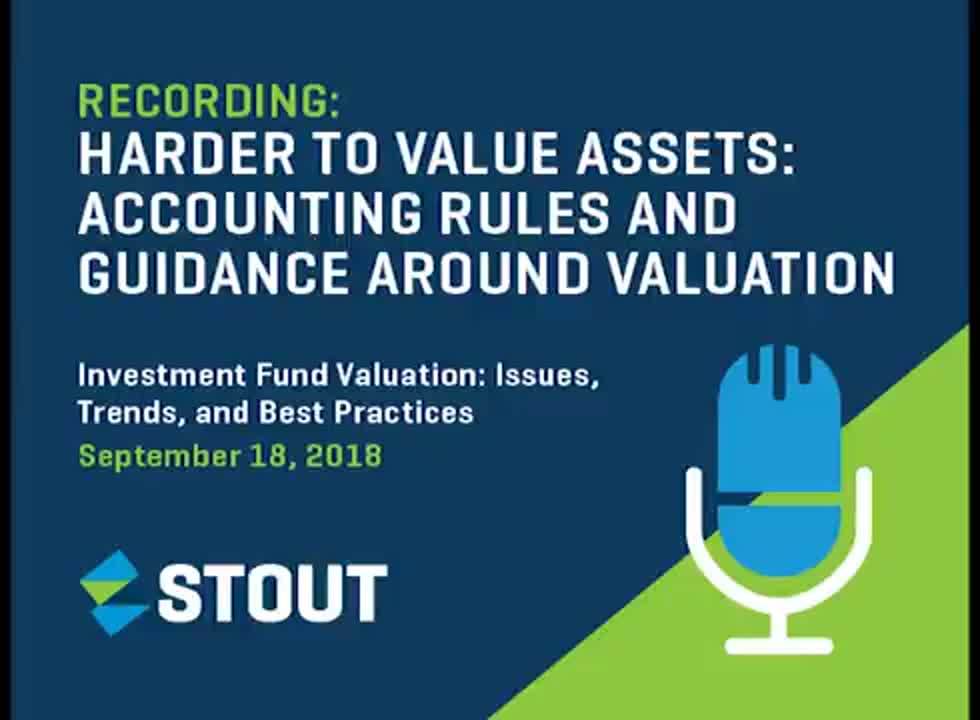Harder-to-Value Assets: Accounting Rules and Guidance Around Valuation A Recap from the Investment Fund Valuation, Issues, Trends, and Best Practices Event
Harder-to-Value Assets: Accounting Rules and Guidance Around Valuation A Recap from the Investment Fund Valuation, Issues, Trends, and Best Practices Event
SEC Office of Compliance Inspections and Examination findings and enforcement actions sparked a trend of increased scrutiny on fund valuation. Especially with the emergence of digital assets/cryptocurrencies as an asset class, valuation is an ever-increasing focus area of regulators. Stout hosted its annual investment fund evaluation event in New York that brought together members of the local investment community and industry experts to discuss these key issues.
The event, moderated by Stout Managing Director Jesse Morton, featured the following panelists:
- Amit Joshi, Chief Accounting Officer, Apollo Investment Corp.
- Thomas Friedmann, Partner, Dechert LLP
- Will Coleman, Director, Technology Advisory Services, Cohen & Co.
- Jamie Spaman, Managing Director, Stout
- Matt Rogers, Director and National Leader of SEC and Accounting Advisory Practice, Stout
In this segment, Jamie Spaman and Amit Joshi provided an overview of accounting rules and guidance around valuation as it relates to harder-to-value assets. Listen to the recording or read the transcription below to get their perspective.

Jesse Morton:
Jamie and Amit, I'll let you guys draw straws in terms of who's going to take this one, but if you guys could just provide an overview of some of the accounting rules and guidance out there around the valuation of harder-to-value assets.
Jamie Spaman:
Sure. I'll just start with a quick background on some of the accounting guidance Jesse already mentioned: ASC Topic 820, Fair Value Measurement. That lays out the groundwork for financial reporting and what is fair value. I'm going to read the definition again because I think it's important to understand some of the elements that people look at when they're doing the fair value.
So again, it's the price to be received when you sell an asset or paid to transfer a liability in an orderly transaction between market participants at the measurement date. The three elements there are: one, an orderly transaction. So, this is not a distress sale. This is not a fire sale or liquidation sale. It's a normal course of business, an orderly transaction. It's also between market participants. It's not related parties, moving something from a fund to a fund or a friend to a friend where we're going to do this deal and then we'll do something else on the other side. So, it's unrelated parties — market participants — at the measurement date.
I think one of the issues in delivering valuations is explaining that, well, we're not going to look at when you exit the investment according to your plan of two or three years down the road, but what could you do today in an orderly transaction. Those elements need to kind of stay top of mind as you look at it.
As ASC 820 also lays out a hierarchy of inputs in different assets, I'm sure a lot of you are familiar with the Level 1, 2, and 3 assets. Level 1 assets are readily marketable, publicly traded, something on the New York Stock Exchange, for example. Pretty straightforward. Level 2 assets may have some observable inputs. They may be pink sheets, they may have broker quotes, or they may have a very similar security that is on the public market. Then, Level 3 assets, there's no publicly traded market, unobservable inputs, you think of private equity, private debt, distress debt as some examples. That's where, as we've been talking about the valuation process, the entity that's doing the fair value has to use assumptions about what other market participants would assume if they were going to do an orderly transaction.
Just for today's discussion, you might think that Level 1 assets would be the most straight forward, that you would never have any issues. But as, I think we're going to do some of the cases, you can see the fraud and the manipulation even with something that we think would be very straight forward.
Amit, you want to add?
Amit Joshi:
Sure. What I would add is that what we come across is many times with Level 1, there is a thin line between Level 2 and Level 3, right? At times, when you get a broker quote, questions are raised around whether it's a Level 2 versus Level 3. Normally, it's very important that each organization, each fund, has a decent leveling policy which clearly lays down all the scenarios based on how you'll consider something Level 2 versus Level 3.
For instance, normally we evaluate whether the input is available based on market transaction and is available to market participants or not. Is the input something which you obtain from outside the organization and is the input available based on a recurring basis? Here, input could be that quote. Then, the quote should not be like one time you got multiple quotes and you called it Level 2, and next quarter or next year you want that quote and you don't get it. Which clearly is an indication that, perhaps, this is more thinly traded and should be Level 3.
As you're evaluating Level 2 and Level 3 investments, it's very important that we properly document your policies and procedures. As said in some of the discussion, there has been enforcement action when you've overvalued things. Many funds tend to take conservative estimates and put everything as Level 3. Accounting principles don't allow you either. You have to make a proper judgment and ensure your policies and procedures clearly lay down how you'll go about identifying something as Level 2.
I would also add that around some of the challenges which you face in valuation, as you're valuing hard-to-value assets, these are illiquid names. It's important to understand what kind of assumptions go into it. We work closely with independent valuation firms to evaluate those investments and it's very important that as you're going through those unobservable inputs, you are evaluating what kind of changes can happen. The guidance ASC 820 lays down clearly around different approaches which one can take - either an income approach or a market approach or an asset-based approach. Many times, for a specific valuation, we use multiple approaches. What at times we have found is that you are doing both approaches, but you're not reconciling the approaches. It's a good step to do multiple approaches, but it's also very important that you reconcile because, eventually, both approaches should give you the same value. Because then the fair value will be one number which will go into your financial statement. That's very important to ensure that that's happening.
At times, you are using a market approach, you are using public comps, and the public comps could be much larger companies which are much bigger in size and have grown much more than the portfolio company you are trying to value. It's very important, again, in those scenarios you adjust the public comp to adjust the valuation accordingly based on that portfolio company which you are trying to value.





